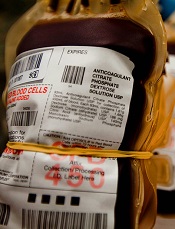User login

Engineers have devised a method that could allow for faster preparation of frozen red blood cells (RBCs), according to research published in Biomicrofluidics.
It’s already possible to cryopreserve RBCs in the presence of 40% glycerol, but the post-thaw washing process can take an hour or more.
Initial experiments and computer modeling suggest this process can be streamlined to take as little as 3 minutes, using a membrane-based microfluidic device.
This could make it more feasible to use frozen blood in emergency or time-constrained medical situations.
“Only a small fraction of our blood supply is now frozen because it’s often impractical to wait so long when a transfusion is needed immediately,” said study author Adam Higgins, PhD, of Oregon State University in Corvallis.
“Because of that, our entire system depends on constantly balancing the use and supply of blood products that can only last 6 weeks or less with refrigeration. This is difficult and can lead to loss of outdated blood, periodic shortages, and other inefficiencies that could be solved with the use of frozen blood.”
With this in mind, the researchers explored the potential for rapid glycerol extraction using a membrane-based microfluidic device.
They theorized that extremely tiny microchannel plates and membranes could be used to precisely control the removal of glycerol at a time scale of seconds, without causing excessive osmotic damage.
The team developed a mass transfer model that allowed them to predict glycerol removal, as well as the resulting cell volume changes.
Results of the researchers’ experiments were in line with the predictions and suggest it is possible to reduce the glycerol concentration by more than 50% without excessive hemolysis.
Now, the team hopes to create working prototypes of the needed technology for further development and testing of this concept. They believe an optimized process may be even faster than the 3 minutes now being predicted. ![]()

Engineers have devised a method that could allow for faster preparation of frozen red blood cells (RBCs), according to research published in Biomicrofluidics.
It’s already possible to cryopreserve RBCs in the presence of 40% glycerol, but the post-thaw washing process can take an hour or more.
Initial experiments and computer modeling suggest this process can be streamlined to take as little as 3 minutes, using a membrane-based microfluidic device.
This could make it more feasible to use frozen blood in emergency or time-constrained medical situations.
“Only a small fraction of our blood supply is now frozen because it’s often impractical to wait so long when a transfusion is needed immediately,” said study author Adam Higgins, PhD, of Oregon State University in Corvallis.
“Because of that, our entire system depends on constantly balancing the use and supply of blood products that can only last 6 weeks or less with refrigeration. This is difficult and can lead to loss of outdated blood, periodic shortages, and other inefficiencies that could be solved with the use of frozen blood.”
With this in mind, the researchers explored the potential for rapid glycerol extraction using a membrane-based microfluidic device.
They theorized that extremely tiny microchannel plates and membranes could be used to precisely control the removal of glycerol at a time scale of seconds, without causing excessive osmotic damage.
The team developed a mass transfer model that allowed them to predict glycerol removal, as well as the resulting cell volume changes.
Results of the researchers’ experiments were in line with the predictions and suggest it is possible to reduce the glycerol concentration by more than 50% without excessive hemolysis.
Now, the team hopes to create working prototypes of the needed technology for further development and testing of this concept. They believe an optimized process may be even faster than the 3 minutes now being predicted. ![]()

Engineers have devised a method that could allow for faster preparation of frozen red blood cells (RBCs), according to research published in Biomicrofluidics.
It’s already possible to cryopreserve RBCs in the presence of 40% glycerol, but the post-thaw washing process can take an hour or more.
Initial experiments and computer modeling suggest this process can be streamlined to take as little as 3 minutes, using a membrane-based microfluidic device.
This could make it more feasible to use frozen blood in emergency or time-constrained medical situations.
“Only a small fraction of our blood supply is now frozen because it’s often impractical to wait so long when a transfusion is needed immediately,” said study author Adam Higgins, PhD, of Oregon State University in Corvallis.
“Because of that, our entire system depends on constantly balancing the use and supply of blood products that can only last 6 weeks or less with refrigeration. This is difficult and can lead to loss of outdated blood, periodic shortages, and other inefficiencies that could be solved with the use of frozen blood.”
With this in mind, the researchers explored the potential for rapid glycerol extraction using a membrane-based microfluidic device.
They theorized that extremely tiny microchannel plates and membranes could be used to precisely control the removal of glycerol at a time scale of seconds, without causing excessive osmotic damage.
The team developed a mass transfer model that allowed them to predict glycerol removal, as well as the resulting cell volume changes.
Results of the researchers’ experiments were in line with the predictions and suggest it is possible to reduce the glycerol concentration by more than 50% without excessive hemolysis.
Now, the team hopes to create working prototypes of the needed technology for further development and testing of this concept. They believe an optimized process may be even faster than the 3 minutes now being predicted. ![]()